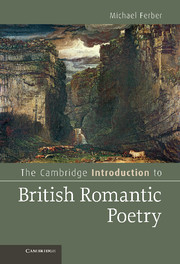Book contents
- Frontmatter
- Contents
- Preface
- Acknowledgments
- Chapter 1 Introduction
- Chapter 2 The poet
- Chapter 3 “Tintern Abbey”
- Chapter 4 Romantic odes
- Chapter 5 The French Revolution
- Chapter 6 Romantic sonnets
- Chapter 7 Romantic love lyrics
- Chapter 8 Romantic ballads
- Chapter 9 Romantic epics and romances
- Chapter 10 Romantic verse drama
- Chapter 11 Romantic satire
- Appendix
- Notes
- Further reading
- Index
Chapter 11 - Romantic satire
Published online by Cambridge University Press: 05 June 2012
- Frontmatter
- Contents
- Preface
- Acknowledgments
- Chapter 1 Introduction
- Chapter 2 The poet
- Chapter 3 “Tintern Abbey”
- Chapter 4 Romantic odes
- Chapter 5 The French Revolution
- Chapter 6 Romantic sonnets
- Chapter 7 Romantic love lyrics
- Chapter 8 Romantic ballads
- Chapter 9 Romantic epics and romances
- Chapter 10 Romantic verse drama
- Chapter 11 Romantic satire
- Appendix
- Notes
- Further reading
- Index
Summary
If this book were a survey of British Romantic poetry rather than an introduction to it, it would have chapters on several kinds of poetry that it has so far neglected or only glanced at. One kind we might awkwardly call the “brief narrative poem other than a ballad.” It would include, for example, Blake’s The Book of Thel (1789), America: A Prophecy (1793), and indeed all of his shorter “prophetic books” of the 1790s; Wordsworth’s tragic stories “The Ruined Cottage,” written in 1798 and incorporated into The Excursion in 1814, “The Brothers” (1800), and “Michael: A Pastoral Poem” (1800); Byron’s “Turkish” tales, beginning with The Giaour (1813), as well as his disturbing apocalyptic vision “Darkness” (1816); Shelley’s Alastor (1816), which tells of the life and death of an alienated poet; Keats’s Lamia (1820) and The Eve of St. Agnes (1820), though they might be defined as brief romances; and the many poems gathered in Hemans’ Tales, and Historic Scenes, in Verse (1819) and Records of Woman (1828).
Another kind is elegy. It had a broad meaning as a meditative poem on a serious theme, but even in its narrow sense as a poem of lament over the dead there are many Romantic examples, of which the greatest is Shelley’s Adonais (1821), on the death of Keats. The genre would also include Coleridge’s “On Receiving an Account that his Only Sister’s Death Was Inevitable” (1791) and “Monody on the Death of Chatterton” (1794); Wordsworth’s “Lucy” poems (1800), “Elegiac Stanzas” (1807) on the death of his brother, and “Extempore Effusion Upon the Death of James Hogg” (1835); Byron’s “Elegy on Newstead Abbey” (1807) and “Monody on the Death of Sheridan” (1816); Hemans’ “The Grave of a Poetess” (1828); Landon’s “Stanzas on the Death of Mrs Hemans” (1835); and Elizabeth Barrett Browning’s “L. E. L.’s Last Question” (1839), on the death of Landon.
- Type
- Chapter
- Information
- The Cambridge Introduction to British Romantic Poetry , pp. 207 - 216Publisher: Cambridge University PressPrint publication year: 2012

